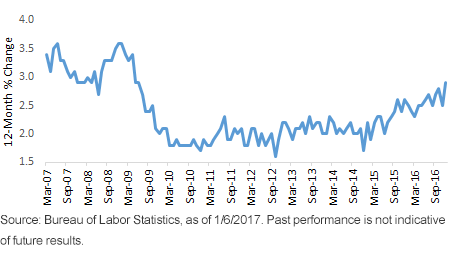U.S. Treasuries: The Fed 'Wage'rs a Bet


This apparent new focus is the flip side of the usual point of emphasis as the nonfarm payroll figure typically captured the lion’s share of the headlines and the market’s attention. However, with the unemployment rate remaining below the 5% threshold for the last eight consecutive months (4.7% in December), Federal Reserve (Fed) rhetoric has begun to center on the notion that the economy is at, or close to, full employment and that the prospects for potential fiscal stimulus this year could increase the odds of a further decline in joblessness. This, in turn, could lead to upward pressure on wages. This potential “undershoot” in the unemployment rate was a point of discussion according to the December Federal Open Market Committee (FOMC) minutes and will no doubt be an area of close scrutiny for policy makers in the months ahead.

So let’s turn our attention to the “star” of this blog post, average hourly earnings (AHE). According to the Bureau of Labor Statistics, the year-over-year rate increase for AHE rose by 0.4 percentage points to +2.9%, the highest reading since mid-2009. As the graph above illustrates, since hitting a recent low of +1.7% in December 2014, wages have been on an upward trend over the last two years. It has not always been a “one-way ticket” to the upside, but an overall upward pattern has been clearly discernible. The data for this series goes back only about 10 years, and the average rate of increase is placed at +2.4%. Unfortunately, this figure is a bit skewed to the downside because of the lagged negative effects from the great recession of 2010–2012. For the record, the highpoint is +3.6%, which, coincidentally, was registered back in 2009 as well.
Conclusion
While it is highly unlikely that the Fed will raise rates at its next meeting on Feb 1, the policy makers will be watching wage trends closely. That being said, we believe fiscal policy expectations still “Trumps” wages for now, and the Fed will probably want to wait and see what comes out of Washington, D.C., on that front before making a move (unless incoming data surprisingly forces its hand earlier). If this scenario plays out and wages begin to accelerate more meaningfully, the UST discussion could turn to the Fed being behind the curve as 2017 progresses. As of this writing, the December 2017 Fed Funds Futures contract was still priced for only two rate hikes for this year. As far as a UST update, during the first week of January, the 10-Year yield had fallen as much as 25 basis points (bps) from its December 15 peak, as it appears the one-way “rates going up, bear steepener” trade got overly crowded and ran out of steam, at least for now.
Unless otherwise noted, source is Bloomberg, as of 1/6/2017.


